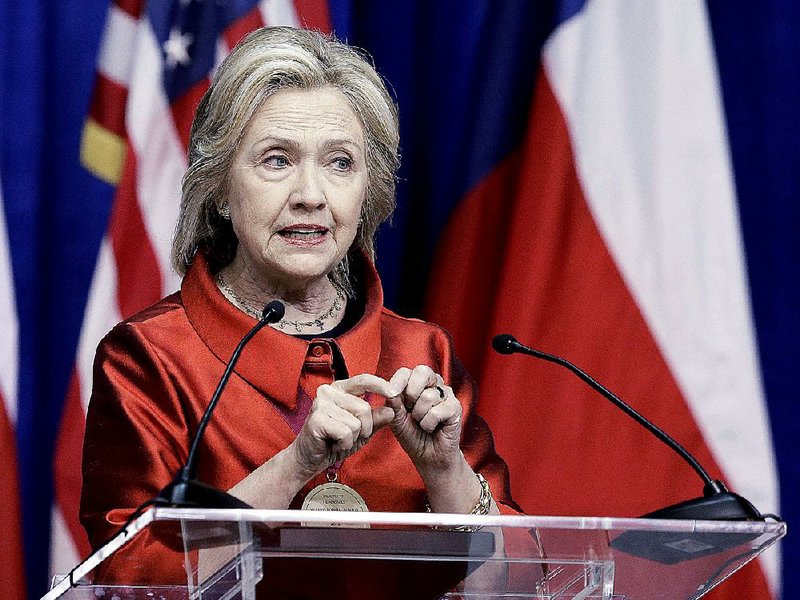WASHINGTON -- Hillary Rodham Clinton is dispensing with the nationwide electoral strategy that won her husband two terms in the White House and attracted white, working-class voters and great stretches of what is now red-state America back to Democrats.
Instead, aides say, she is planning to retrace Barack Obama's far narrower path to the presidency, focusing her campaign more on mobilizing supporters in the Great Lakes states and in parts of the West and South than on trying to sway undecided voters.
Clinton's aides say it is the only way to win in an era of heightened polarization, when a declining pool of voters is truly up for grabs. Her liberal policy positions, they say, will fire up Democrats, which will be much less difficult to do than trying to win over independents in more hostile territory.
This early in the campaign, however, forgoing a determined outreach effort in all 50 states, or even most of them, could mean missing out on the kind of spirited conversation that can be a unifying feature for a presidential election. And it could leave Clinton, if she wins, with the same difficulties Obama has faced in governing with a Republican-controlled Congress.
It is causing consternation among Democrats in conservative states that could get short shrift by her campaign or be bypassed altogether.
When Bill Clinton reclaimed the presidency for Democrats in 1992, his road to the White House ran through Southern and Southern-border states filled with what were then a precious commodity: swing voters.
Twenty years later, Obama convincingly won a second presidential term without competing in states like Kentucky, Louisiana, Tennessee or West Virginia that had powered Bill Clinton. And because of his strong appeal among liberals, Obama won even while losing among independent voters.
As Hillary Clinton intensifies her campaign for the Democratic nomination, it is clear from her policy stances, her hiring and her focus on data-driven organizing that her strategy is modeled on Obama's, not her husband's, campaign strategy.
If she wins, it will suggest that the Obama coalition of young, nonwhite and female voters is transferable to another Democrat. And it will validate the idea that energizing core supporters is more important in presidential contests than targeting the undecided. To the architects of the Obama strategy, Clinton's approach is not mere homage. It is unavoidable, given that there are few genuine independents now and that technology increasingly lets campaigns pinpoint their most likely voters.
"If you run a campaign trying to appeal to 60 to 70 percent of the electorate, you're not going to run a very compelling campaign for the voters you need," said David Plouffe, a top Obama strategist who has consulted informally with Clinton.
So to Democrats in states where Hillary Clinton is unlikely to compete, her relying on Obama's map would be worrisome. It would not only further diminish beleaguered state parties but also leave Clinton with a narrower margin for error.
"Go ask Al Gore," Sen. Joe Manchin III, D-W.Va., said about the risk of writing off states such as his, where Democratic presidential candidates prospered until 2000. "He'd be president with five electoral votes from West Virginia. So it is big, and it can make a difference."
Clinton's strategists appear unmoved.
"I think everybody understands how tough it's going to be next year if we get through the primary," said Robby Mook, Clinton's campaign manager. "So I'm not concerned about hand-wringing on the strategy."
Aides acknowledge that Clinton's map will closely resemble Obama's, with roughly the same eight or so key states as in the previous two presidential elections and with the possibility of competing in historically Republican states such as Arizona where the demographics increasingly favor Democrats.
Clinton and her husband expressed concern last year when Democratic turnout fell precipitously. Recognizing that Democrats have to be galvanized to show up at the polls, Clinton's advisers used surveys and focus groups to assess the risks of running a strongly liberal campaign. They concluded there were few.
So she is embracing the central lesson of the Obama school: that voters turn out when they believe an election makes a difference and when their party's standard-bearer is a champion on issues important to them.
By emphatically staking out liberal positions on gay rights, immigration, criminal justice, voting rights and pay equity for women, Clinton is showing core Democratic constituencies that she intends to give them a reason to support her.
The stoke-the-base approach is a hallmark of Clinton's young campaign manager, Mook. He used similar tactics to lift Gov. Terry McAuliffe of Virginia to victory in 2013, in a race both Clintons watched closely.
It is a starkly different style from that of Hillary Clinton's 2008 campaign, when she was often concerned about being seen as too liberal to appeal to centrists.
This time, Pfeiffer said, "she hired people with a sense of where the electorate is now, not where it was in 1992."
Information for this article was contributed by Ashley Parker of The New York Times.
A Section on 06/07/2015


